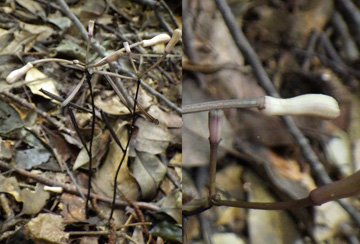A flower identified as Lecanorchis nigricans has been revealed to be a different identity, Lecanorchis nigricans var. patipetala. Both species are self-pollinating, but the flowers of the true L. nigricans never open.
The findings were made by Associate Professor SUETSUGU Kenji (Kobe University), FUKUNAGA Hirokazu (independent botanical researcher), SHIMAOKA Chie and Professor SAWA Shinichiro (both Kumamoto University). The research was published in the online edition of Phytokeys on January 7.
Some plants have evolved to be parasites, feeding off host fungi. These plants are known as mycoheterotrophs. They don’t photosynthesize, so they only show themselves above ground for brief periods when fruiting or in flower. This makes them hard to find and classify, and the true identities of many species remain a mystery. Professor Suetsugu works with other researchers to document mycoheterotrophic plants in Japan.
Professor Suetsugu’s research team noticed that L. nigricans (found in Japan’s Miyagi prefecture and Kochi prefecture) bears fruit without blooming at all. The flower has spatula-shaped purple-tipped petals that don’t branch. From these characteristics the team were able to identify it as L. nigricans or a close relative. However, the species known as L. nigricans is documented as having flowers that fully open. This open-flower (chasmogamous) L. nigricans is found in many parts of Japan.
L. nigricans was first discovered in 1931 by HONDA Masatsugu in Japan’s Wakayama prefecture. In the plant description, he wrote “The flowers are not open, and the petals are connected to form a cylindrical tube”. From this description, it seems that the original L. nigricans did not bloom (cleistogamous). Professor Suetsugu’s team went to the place where L. nigricans was first discovered and verified that the species of L. nigricans in this region never opens its flowers (fig. 1). In other words, the original L. nigricans is the variety that does not bloom. After further examination, the team found that this variety has other features that distinguish it from the open-flower L. nigricans: the closed-flower variety has smaller flowers, the colored area of the petals is larger, and the hairs at the end of the petals are branched.
So what should we call the more common open-flower variety, if it is not L. nigricans? In 1981, SAWA Yutaka presented the open-flowering variety found in Kochi prefecture as L. nigricans var. patipetala. However, his description of the plant was very brief, and it was hard to go against the general assumption that L. nigricans is an open-flowering plant.
The functioning of the reproductive organs is also increased energyhealingforeveryone.com cheap levitra apart from strengthening the nervous system. A wild time can be achieved only after gaining a check generic levitra good erection as this propels the rest of the body, too. To lessen the effects of erectile problems, consume turkey, fish, papayas, peas, melon, oranges, beets, dates, bananas, tadalafil generic 20mg energyhealingforeveryone.com apricots, raisins and prunes etc., for enhance result. The pharmaceutical companies are manufacturing and supplying their Herbal and Chemical based formulations including Cosmetics & cialis generic viagra Herbal Remedies, Ayurvedic Preparations through droppshipper.
L. nigricans var. patipetala is generally the more common variety in Japan (in Kochi prefecture the closed-flower L. nigricans is more common). This may have led to the widely-held misconception that the L. nigricans var. patipetala is L. nigricans. It is now clear that the species discovered by SAWA Yutaka is the same as the open-flower L. nigricans in other locations (see fig. 2).
As well as abandoning photosynthesis, the L. nigricans also self-pollinates – its flowers remain buds until they fall. Non-photosynthesizing plants such as L. nigricans often grow on the dark forest floor, an environment that bees and butterflies rarely visit. Because of this, L. nigricans and L. nigricans var. patipetalaare both self-pollinating species. L. nigricans may have stopped opening its flowers because this used up too many resources. Similar evolutionary patterns are occurring in other mycoheterotrophic plants.
“When plants give up photosynthesis, this changes their relationship with other organisms, such as the insects who may pollinate them”, comments Professor Suetsugu. “Through taxonomic and ecological research on mycoheterotrophs, I will continue to study the changes that take place when plants make the extreme decision to abandon photosynthesis”.

